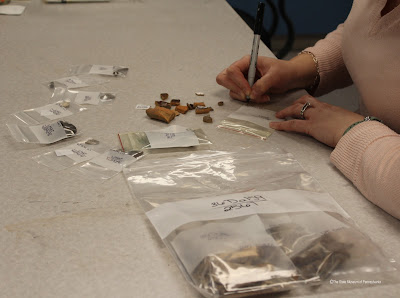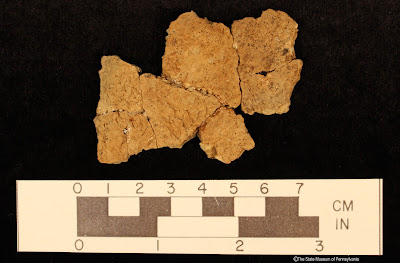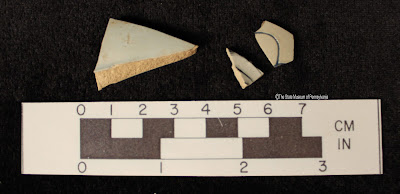Here we are, the Workshops in
Archaeology and Thanksgiving are over and the Pennsylvania State Farm Show and
Christmas season have begun. As we prepare our exhibit for the Farm Show in
January 2018, the lab archaeologists and ever valued volunteers, have been hard
at work processing the artifacts found at Fort Hunter this past field season. Today
we are going to take a brief look at what happens to the artifacts once they
come into the lab from the field and where we are in that process with this
year’s artifacts.
As mentioned previously in this
blog, a general rule of thumb for the time it will take to fully process
artifacts in the lab is approximately seven days of lab work for each day of
field work, depending on the quantity and types of artifacts found. With the
help of our volunteers this time is cut down a bit, but it is still a lot of
work and a long process.
The initial steps for processing
any collection in the lab is to organize and record the provenience information
from field bags through the preparation of a digital field bag inventory. The
field bags are then organized by unit and level allowing for easy processing
later on.
View of the field bag
inventory
Field bags organized by
unit and level in bins ready to be laid out for washing.
Once this is completed, the
artifacts are laid out by bag on trays and the process of cleaning the
artifacts through washing, dry brushing, or other conservation techniques
begins. As can be seen above, we have already emptied a few bins of field bags
and the image below shows some of the artifacts out and ready to be washed.
Artifacts being
cleaned, washing on the left, dry brushing on the right
As the artifacts are cleaned and
air dried, the next step in the process begins, labeling. Artifacts are labeled
with the site number, in the case of Fort Hunter the site number is 36Da159,
and the catalog number, which identifies the location where the artifact was
found. Catalog numbers are determined based on the provenience information
recorded from the field bags.
Clean artifacts
(fire-cracked rock) being labeled
Once the artifacts are properly
labeled, they are identified and bagged by type within each catalog number and
then inventoried in a digital format, to make for easy lookup for research or
exhibit creation.
Artifacts being
identified and bagged for final curation
Due to the great effort of our
volunteers, it is possible to work on multiple steps of this process at one
time. This allows us to process the artifacts in an efficient and effective
manner. (For more information on how artifacts are processed in the state
museum archaeology lab check out our previous blog, Behind the Scenes at The State
Museum—Processing the Fort Hunter Collection: What happens after the field work
is done?)
Currently in the archaeology lab,
we have completed the initial organization and recordation of proveniences as
well as the identification of catalog numbers for each provenience. Washing,
labeling and identifying/bagging are currently occurring in the lab every day.
This year we are taking our processing
one step further by attempting to mend, or put back together, prehistoric
pottery fragments to see if we can identify one or more vessels. This has
proven difficult as there are many very tiny pieces of pottery and many of the
larger pieces do not fit back together, but some progress has been made as can
be seen in the pictures below.
Staff archaeologist
attempting to mend pottery fragments
As we process the artifacts, it
becomes more clear what types of artifacts are present in the collection and
this year we seem to have an abundance of prehistoric artifacts such as stone
waste flakes and tools, pottery and bone. This said, there are also numerous
historic artifacts. Though very few of them date to the fort period they still
help tell the story of the landscape. These artifacts include buttons, musket
balls, butchered bone, nails of varying types and other architectural materials,
historic ceramics and glass; as well as more modern artifacts such as plastic
and Styrofoam.
Here is a glimpse at some of the more notable artifacts
we have uncovered from this year thus far:
Prehistoric artifacts:
Shell bead, possibly
with incised markings on the top and bottom surfaces
Rim and neck sherds of
Owasco cordmarked pottery type, dating to c. 1200 to 1300 AD (Ritchie 1965).
Additional rim, neck
and body sherds from the Owasco tradition.
Unknown pottery type,
vessel body fragments mended back together.
Vessel body sherd from
an exterior and interior cord marked vessel, also mended together
.
Incised rim sherd fragment of a Shenks Ferry Tradition vessel.
Projectile points: top row: Madison type triangle point dates to the late
Late Woodland Period (AD. 1450 - 1600.), second row down Rossville-like point type, dates to the Middle
Woodland Period (1,000 BP. – 2,100 BP.) third row down: Lehigh/ Koens-Crispin
point type, dates to the early Transitional Period (4,350 BP. – 4,850 BP.),
bottom row right: the large broadspear/ knife, dates to the Transitional/Late Archaic
Period (4,350 BP. – 6,850 BP.) bottom left: this point which could fall within Late
Archaic through the Middle Woodland periods.
(Custer 2001, PHMC 2015, Ritchie 1971)
Historic period
artifacts:
Tin glazed earthenware
(left) and scratch blue salt glazed stoneware (right). Both fall within the
French and Indian War time period, though all were found in mixed contexts.
Musket Balls of varying
sizes and date ranges.
Gun Flint
Brass and pewter buttons
dating around the late 18th and 19th centuries.
As usual, the fort at Fort Hunter
remains elusive, but each year we find little hints of its existence through
artifacts. We continue to learn more and more about the landscape and how human
occupation has impacted the land through the thousands of years of use that we
have been able to identify through our excavations. We hope you have enjoyed
this update on what is happening to the artifacts found at Fort Hunter during
the 2017 field season and we wish you all a wonderful and safe holiday season!
References:
Custer,
Jay F.
2001 Classification
Guide for Arrowheads and Spearpoints of Eastern Pennsylvania and the Central
Middle Atlantic. Commonwealth of Pennsylvania, Pennsylvania Historical and
Museum Commission, Harrisburg, Pennsylvania.
Pennsylvania
Historical & Museum Commission
2015 Pennsylvania
Archaeology: Time Periods. Electronic document, http://www.phmc.state.pa.us/portal/communities/archaeology/native-american/time-periods.html.
Ritchie,
William A.
1965 The
Archaeology of New York State.
The Natural History Press, Garden City, New York
1971 A
Typology and Nomenclature for New York Projectile Points. University of the
State of New York, State Education Dept. Albany, New York. Originally published
1961, Bulletin No. 384, New York State Museum and Science Service.


















No comments:
Post a Comment